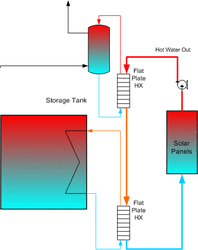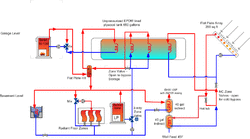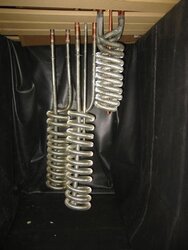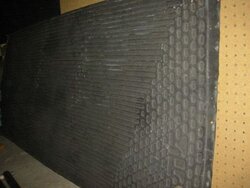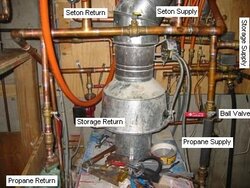The motivation for the design is to have two different temperature systems.
1. domestic hot water and hot tub (run from 200F down to 120F)
2. radiant floor (run from 140F down to 90F)
The unpressurized and pressurized storage is a result of what I already have - a 600 gallon EPDM lined box and two 80 gallon storage tanks and a 35 gallon well pressure tank (for expansion).
The solar is to heat an indirect hot water tank first and then the unpressurized storage.
Temperature sensors will determine the state of the zone valves and pumps and only allow warmer fluid to flow into the loads.
The Seton wood boiler is located physically further away from other components to minimize unwanted charging from storage - additional zone valves may be added to ensure no flow through the Seton when heating from storage.
The propane backup boiler is not shown because I am not sure how to work into the schematic. I want no flow through the propane boiler when heating with the Seton or from storage and I do not want the propane boiler to charge any storage. Not sure how to accomplish this - please help!!
A NFCS (NoFossil Control System) will be used to control all circulators and zone valves and to provide fail safe operation.
Please let me know any comments about how to maintain two temperatures of storage and how to incorporate the propane boiler (only for backup).
Thanks,
Steve
1. domestic hot water and hot tub (run from 200F down to 120F)
2. radiant floor (run from 140F down to 90F)
The unpressurized and pressurized storage is a result of what I already have - a 600 gallon EPDM lined box and two 80 gallon storage tanks and a 35 gallon well pressure tank (for expansion).
The solar is to heat an indirect hot water tank first and then the unpressurized storage.
Temperature sensors will determine the state of the zone valves and pumps and only allow warmer fluid to flow into the loads.
The Seton wood boiler is located physically further away from other components to minimize unwanted charging from storage - additional zone valves may be added to ensure no flow through the Seton when heating from storage.
The propane backup boiler is not shown because I am not sure how to work into the schematic. I want no flow through the propane boiler when heating with the Seton or from storage and I do not want the propane boiler to charge any storage. Not sure how to accomplish this - please help!!
A NFCS (NoFossil Control System) will be used to control all circulators and zone valves and to provide fail safe operation.
Please let me know any comments about how to maintain two temperatures of storage and how to incorporate the propane boiler (only for backup).
Thanks,
Steve


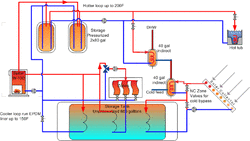
 - none required but I was going to put a Termovar in as soon as I get it from one of the members of Hearth...
- none required but I was going to put a Termovar in as soon as I get it from one of the members of Hearth...